
Credit: Yoshikazu Kato
Collagen is a protein found widely in almost all cells of animals, and scientifically can be used to learn much about an animal’s life history including human being in the present or in the past. Scientists at the Research Institute for Humanity and Nature (RIHN) and Japan Fisheries Research and Education Agency (FRA), Japan, prove this point for Japanese flounder by measuring isotope ratios in vertebral-bone collagen. The new study, which can be read in Marine Biology, shows that there exist behavioral groups of fish with different migrating and/or feeding patterns.
A school of fish will decide their habitat on fundamental needs for survival, such as food availability and safety for reproduction and nursing offspring. Multiple methods have been applied for tracing fish movement, such as telemetry, tagging or analysis of otolith. Examining the stable isotope ratios in several body parts, however, provides unique insights on fish life history.
“Juveniles are interesting, because this is the stage when the fish leave the nursery and begin exploring deeper parts of the sea. Even in adults, however, life-span records are well preserved in their vertebral centrum, cone-shaped layered structure in fish vertebra, as the form of stable isotope ratios of several elements. It allows us to reconstruct individual migration and feeding history,” said RIHN ex-researcher Dr. Yoshikazu Kato, the lead author of the study.
Kato and his colleagues examined a wild population of Japanese flounder (aralichthys olivaceus) in Sendai Bay, off the Pacific coast of northern Japan. The fish was chosen for their important commercial status in Japan.
The migratory and feeding habits of the fish have been well studied in the past, but little is known about how their habits change with age and are diverse among individuals that belongs genetically uniformed group.
Adult fishes were collected at four sampling sites in the bay. Then, carbon and nitrogen stable isotopes of collagen in their vertebral centrum were analyzed chronologically. A non-linear time series analysis using both stable isotope ratios distinguished fishes collected at a site from fishes at the other three sites, suggesting these fishes used a different habitat and/or diet throughout most of their lifetimes. By analyzing stable isotope ratios of nitrogen in amino acids, Kato and his colleagues also detected migrations from shallow nursery to deeper habitats and changes of their foods.
These findings, Kato notes, suggest that when considering effective management and conservation policies, scientists should recognize that not all Japanese flounder will respond the same.
“Our findings indicated that Paralichthys olivaceus are not just a homogenous group in behavior but of at least two different groups who have different migration patterns. As their habitat changes, either naturally or through man-made effects, we expect these behavioral groups will respond differently,” he said.
###
Media Contact
Yoshikazu Kato
[email protected]
Related Journal Article
http://dx.





